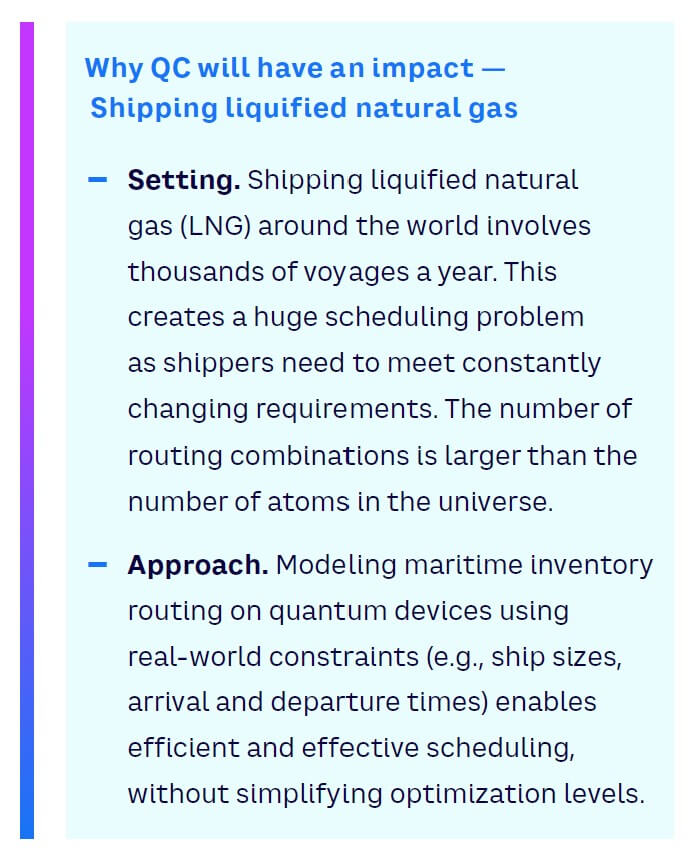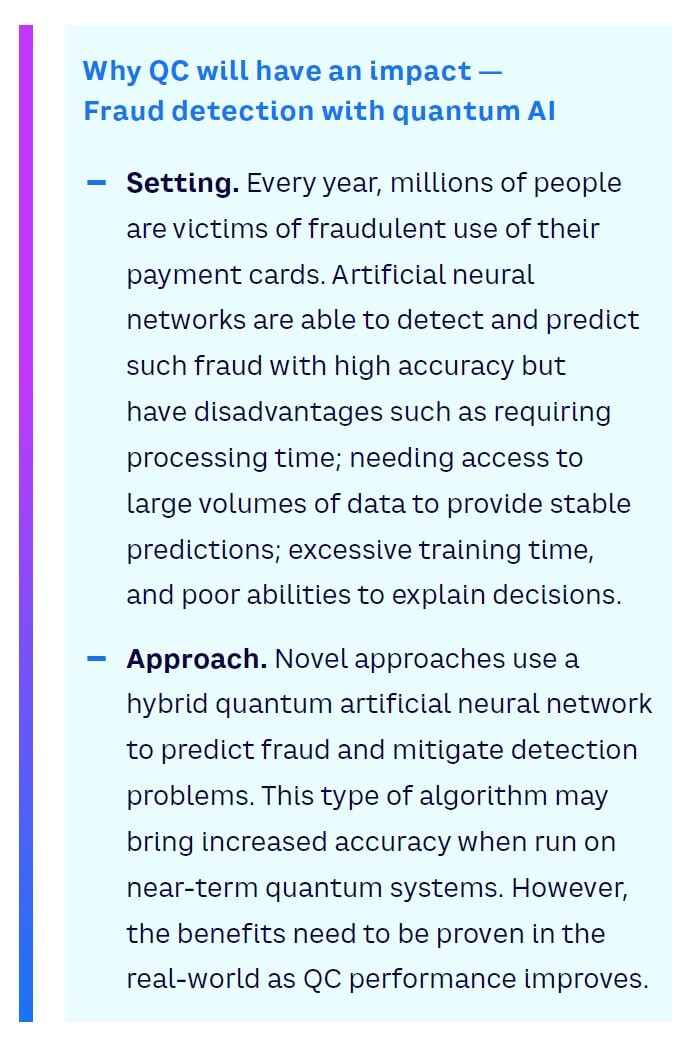
Quantum computing (QC) is widely recognized as a transformative future technology with the potential to significantly change business and society. However, our understanding of it is bedeviled by misunderstandings and misconceptions. This Viewpoint provides a brief review of QC myths, applications, and impacts, and why companies should be taking action now to move up the learning curve.
WHAT IS A QUANTUM COMPUTER?
Quantum computers operate in a completely different manner from conventional ones. Quantum physical phenomena allow for computing capabilities far beyond those of conventional computers. Most significantly, rather that being based on bits, which can only have a value of 0 or 1, quantum computers are based on qubits that can also exist in a state of “superposition,” and the value of their readout is probabilistic rather than deterministic. Together with the phenomenon of “entanglement,” which effectively links qubits, computing power grows exponentially with each additional qubit. QC therefore has the theoretical capability to solve so-called intractable problems involving exponentially increasing complexity, in fields like simulation, optimization, machine learning (ML), and cryptography.
This potential has created enormous interest from business and academic communities, with many tens of billions of dollars invested in QC development. However, harnessing QC benefits requires organizations to see through the hype, overcome several common myths, and envision how QC can best fit into their business. Not only this, organizations should also understand QC’s broader potential impact on issues such as sustainability, safety, and society itself. This Viewpoint provides more detail on all these issues; for further insight, see Arthur D. Little’s Blue Shift Report, “Unleashing the Business Potential of Quantum Computing.”
BUSTING 4 QC MYTHS
Myth 1: The quantum age won’t arrive for many years
Recent acceleration in quantum research indicates major steps toward achieving stable and error-reduced quantum computers — a key challenge in QC technology up to now. Cloud-based, low-temperature quantum computers with around 4,000 qubits (like the IBM Kookaburra) are predicted to be available starting in 2025, and systems that can be operated at room temperature are already planned for around 2028. The capability of these predicted systems will need to be validated; however, there are already QC devices accessible to users, such as quantum annealers and quantum emulators (conventional supercomputers that emulate QC devices). Many organizations have already been using these to create small-scale experimental systems as proofs of concept and to test, debug, and verify quantum algorithms.
Technical achievements and breakthroughs are ongoing. Once successfully deployed, quantum computers have the potential to disrupt business, at a scale perhaps similar to the impact that generative artificial intelligence (GAI) is expected to have. Companies have limited time to prepare for this revolution since the learning curve is steep and challenging. Quantum-native companies will enjoy major advantages over others, perhaps even changing entire industries.
Myth 2: QC is only for cutting-edge applications
There is a persistent belief that the computing power promised by quantum computers will only be used in highly specialized applications such as protein folding or cryptography. In fact, QC applications exist in almost every industry and area of business. For example, in addition to complex problems such as drug discovery and climate modeling, quantum computers can also assist with more mundane problems that are currently held back by computational complexity (see Figure 1).
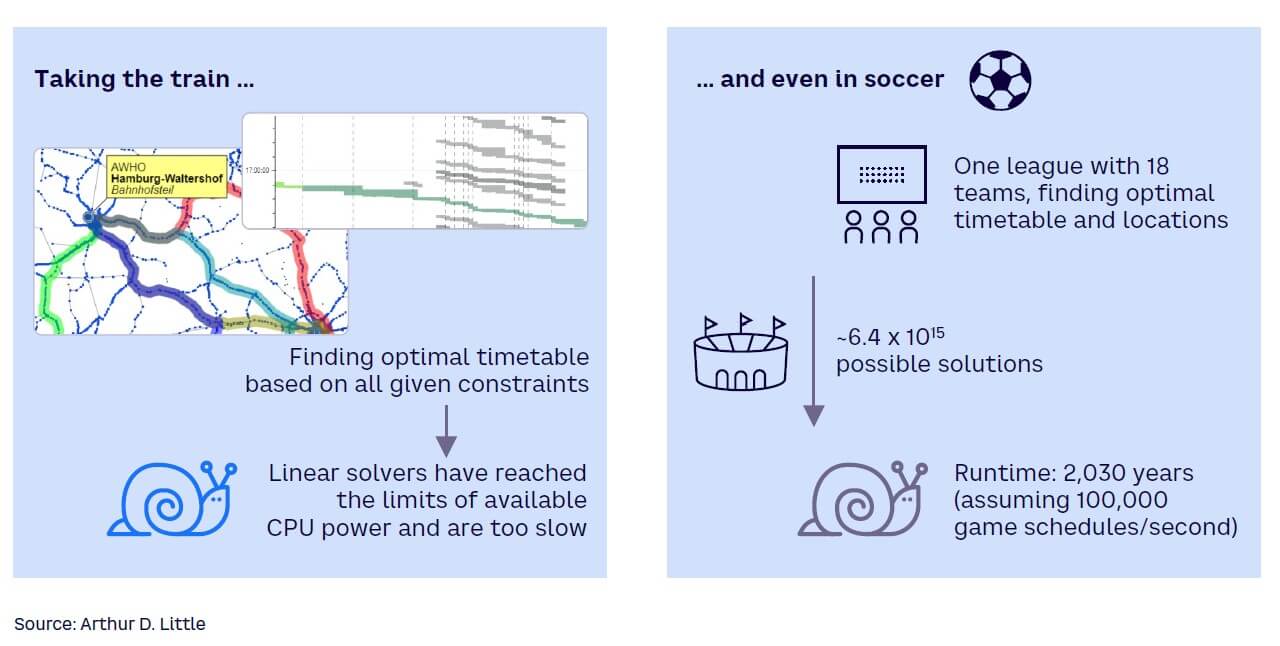
Myth 3: QC doesn’t exist yet, so I can’t start
While full-scale quantum computers are not yet available, it is possible today to access QC devices such as annealers, simulators, and emulators. Valuable work can be done to create and test quantum-inspired algorithms (optimized for the quantum world), which can be run on these devices or on conventional CPU/GPU hardware. Organizations can already do a lot to identify and explore relevant QC applications for their business, negotiate access to QC capacity, engage with the QC ecosystem, develop capabilities, educate business departments about QC’s potential, accelerate cloudification, and adapt IT-compliance rules.
Myth 4: QC is expensive
Complex new technologies such as quantum computers are very costly to develop and implement. However, prices are likely to decrease considerably once the technology begins to mature. In the short term, early quantum computers will be cloud-based systems that customers can access on demand, so they do not have to invest in their own machines and infrastructure. Companies like IBM and D-Wave already offer licenses for access to quantum hardware. Quantum computers may also ultimately offer operating cost advantages over conventional computers, as they theoretically offer more computing power per unit of energy consumption.
SOME PATHWAYS TO BUSINESS IMPACT
Pathway 1: Completely new applications
The exponential increase in computing power from quantum computers will enable highly innovative applications. For example, quantum computers may ultimately enable the creation of realistic digital twins, simulating environments at a level of detail and scale that would be unfeasible with conventional computers. This could allow simulations of complex systems to extend beyond domain-specific individual areas (e.g., a device or a factory) to create broader, more coherent models — we might see simulations that span multiple sectors, cover large mobility ecosystems, or run complex climate or space-mission models.
Pathway 2: True real-time processing capabilities
The first use cases for quantum computers will likely involve accelerating existing optimizations and simulations. Today, complex planning problems require days or weeks of calculation time to render answers, limiting their use to historic analysis and long-term planning. Quantum computers allow the same calculations to be run in real time, delivering faster, more actionable results while dramatically reducing energy costs.
Pathway 3: Optimal rather than just good-enough solutions
For time and cost reasons, today’s optimization methods and simulation environments focus on obvious subsets rather than covering the entire solution space. The results are not fully optimized but are seen as “good enough” under the circumstances. Quantum computers — in their predicted capabilities, overcoming temperature issues and error effects — will combine in-built parallelization and high computing power to deliver optimal solutions based on complete data and variables.
Pathway 4: Accelerated innovation & product development
Quantum computers accelerate the development of complex simulation environments and physically detailed digital twins. Because experiments and tests run entirely in virtual space, they can be completed faster, accelerating product development. Predefined and preplanned test series that require days of processing time can be augmented by agile, what-if experiments that are quickly launched and completed. Combining QC and AI in virtual test environments lets organizations bring people and AI together to experiment and innovate.
SOCIAL & SUSTAINaBILITY IMPACTS
Impact 1: QC could lead to a new understanding of the world
Since their first deployment, computers and digital technologies have provided humanity with new insights. They complement theories and lab experiments, deliver insights into areas too complex for the human brain, and provide accurate future predictions. QC continues this trend, providing in a simplified way a third level of freedom:
-
Anybody. Early computers lived in data centers and were reserved for small groups of specialists. The 1970s introduction of personal computers brought about a first stage of liberation, making them accessible to all and leading to a large-scale creative expansion of digital applications.
-
Anywhere. The mobile Internet brought about the second stage of liberation, with computers and devices able to be easily used anywhere. New usage scenarios and business models sprang up as a result.
-
Anything. Conventional processors cannot overcome Moore’s Law, limiting improvements in performance. In contrast, QC delivers exponential performance increases, expanding what can be calculated and providing completely new insights.
Impact 2: QC could accelerate progress toward sustainability
QC can contribute to a more sustainable world in several ways, for example:
-
Quantum computers can run more complex, real-time simulations, improving control of impacts and optimizing resources (e.g., in industrial manufacturing, global supply chain impacts, and energy grid optimization or farming).
-
Quantum computers run complex calculations much more quickly, saving energy while achieving similar levels of performance (e.g., training on ML procedures).
-
Quantum computers consume less energy due to their physical structure. Current QC energy consumption is an order of magnitude lower than conventional hardware, and room-temperature systems are expected to be nearly two orders of magnitude lower.
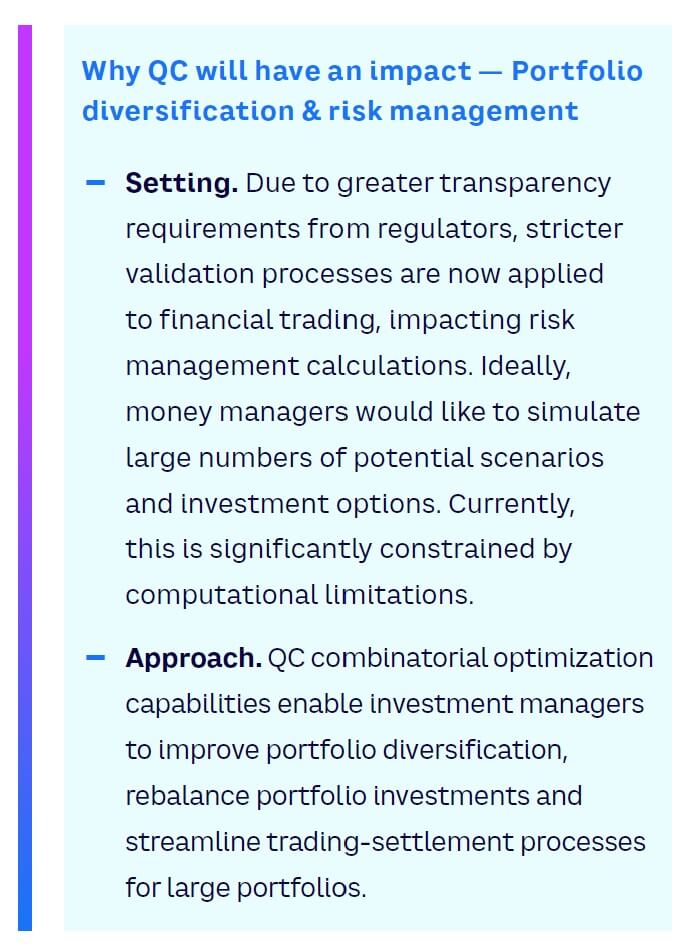
Impact 3: QC perfectly complements AI
QC and AI are closely linked and will have an enormous impact on each other. Research indicates that mathematical algorithms (e.g., matrix multiplication) are a core part of modern AI that can be run more efficiently and quickly on quantum computers compared to conventional computers. For reinforcement learning algorithms, which operate on a trial-and-error basis, QC offers two opportunities.
First (and in combination with Impact 2), more complex but still real-time simulations enhance the exploratory searches of reinforcement learning algorithms. This leads to broader and more realistic solutions for reinforcement learning–based AI models. Second, QC provides the potential to reduce the learning times of these models. This not only leads to shorter training cycles, but also faster model deployment — a case especially relevant in the current GAI hype.
AI can aid in the development and programming of QC applications. For example, AI algorithms can be used to check the quality of QC results, perform error corrections, or assist in quantum algorithm optimization. GAI systems allow automated generation of quantum programming code such as Qiskit, alleviating the bottlenecks being felt from the severe shortage of software developers and QC algorithm modelers.
Impact 4: QC will increase safety & security
There has been considerable, and reasonable, concern about the ability of quantum computers to crack current cryptographic methods, overriding the most commonly used Internet safety protocols. However, quantum computers also offer potentially the best route to provide new security approaches. Quantum key-exchange protocols will increase security by ensuring that communications cannot be hacked. QC can be used to generate unique identification features that are difficult to forge, such as keywords, quantum biometrics, and quantum signatures. Quantum processing can also be used to perform data-sensitive operations efficiently while keeping data protected. Finally, QC will support innovative approaches to fraud detection and cyberattacks. For example, hybrid quantum artificial neural networks can quickly detect patterns behind potential attacks and isolate affected areas. QC can also be used to develop quantum-resistant encryption algorithms, such as the use of grid-based post-quantum cryptography.
FIRST QC USE CASES
Accurately predicting the order in which applications and industries will develop and implement QC is difficult. It will depend on: (1) the capabilities of quantum technologies and (2) a range of factors such as technological progress, investment, and regulatory frameworks. Figure 2 provides an indication on potential areas of QC application.
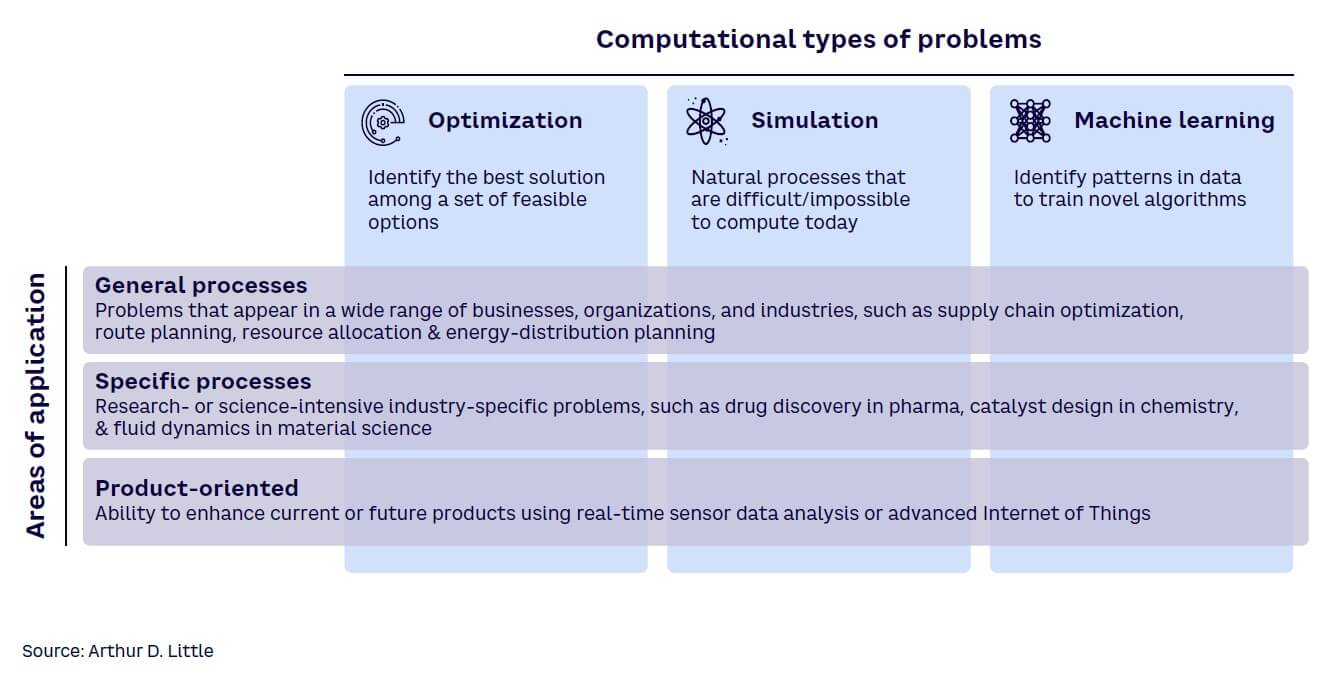
Key examples include the following:
-
Optimization applications and discrete simulations. Processes such as logistics, supply chain management, workforce planning, and finance risk analysis can greatly benefit from QC. What is currently possible only through error-prone coupling of two methods (i.e., data integration) can be done in one place, bringing clear advantages in accuracy and results interpretation. For example, transport organizations will be able to develop continuous simulations covering everything from local events (e.g., passenger traffic at an individual station) to long-distance interconnections.
-
Molecular simulations. Parallel processing theoretically enables faster calculation of molecular properties. Thus, material design and chemical reaction modeling will benefit decisively from QC. This is good news for the pharmaceutical, chemical, and material science sectors, as current simulations require enormous amounts of conventional computing power.
-
AI. QC supports greater use of reinforcement learning methods. These do not require historical training data and can adapt to changing problems, but they have extremely long learning times when deployed on conventional computers. Speeding up algorithms will benefit areas like medical imaging, object recognition, and green technology development.
HOW COMPANIES SHOULD PREPARE FOR QC
As with all technology, successfully embracing QC requires strong preparation and planning. Companies should begin with an analysis of the organization that includes technology requirements, skills, structure, strategy, governance, and corporate culture, along with the identification of potential early use cases and consideration of the costs and potential risks.
Here are five steps that can help companies identify potential applications and prepare for QC availability:
-
Exploration. Explore QC’s potential for the business by looking at your operating model and identify activities, processes, or functions for which simulation, optimization, AI/ML, and cryptography are potentially important.
-
Experiment. Derive and define first use cases and develop minimum viable products; access available QC systems to strengthen their meaning for your business.
-
Stabilization. Deploy proofs of concepts to show tangible business value.
-
Optimization. Incorporate your QC potentials in a comprehensive vision, strategy, and roadmap to plan for your preparational steps.
-
Transformation. If QC shows potential for your business, be confident enough to place quantum computers as part of the company’s DNA, transforming products and processes.
Conclusion
SHATTERING QC MYTHS & MOVING FORWARD
Although QC has developed rapidly over recent years, the necessary degree of computing power to outperform conventional computing (“quantum advantage”) has not yet been reached. However, the QC future is approaching more rapidly than many think, and once it takes off, growth will be exponential. At that point, those companies who still need to move along the steep learning curve may find it impossible to catch up. Businesses should therefore:
-
Consider how they might be affected by QC technology.
-
Brainstorm ways they can take advantage of nascent QC capabilities, such as annealers, and quantum-inspired algorithms.
-
Begin to plan for a future where the power of QC will be a key contributor to competitive advantage.

